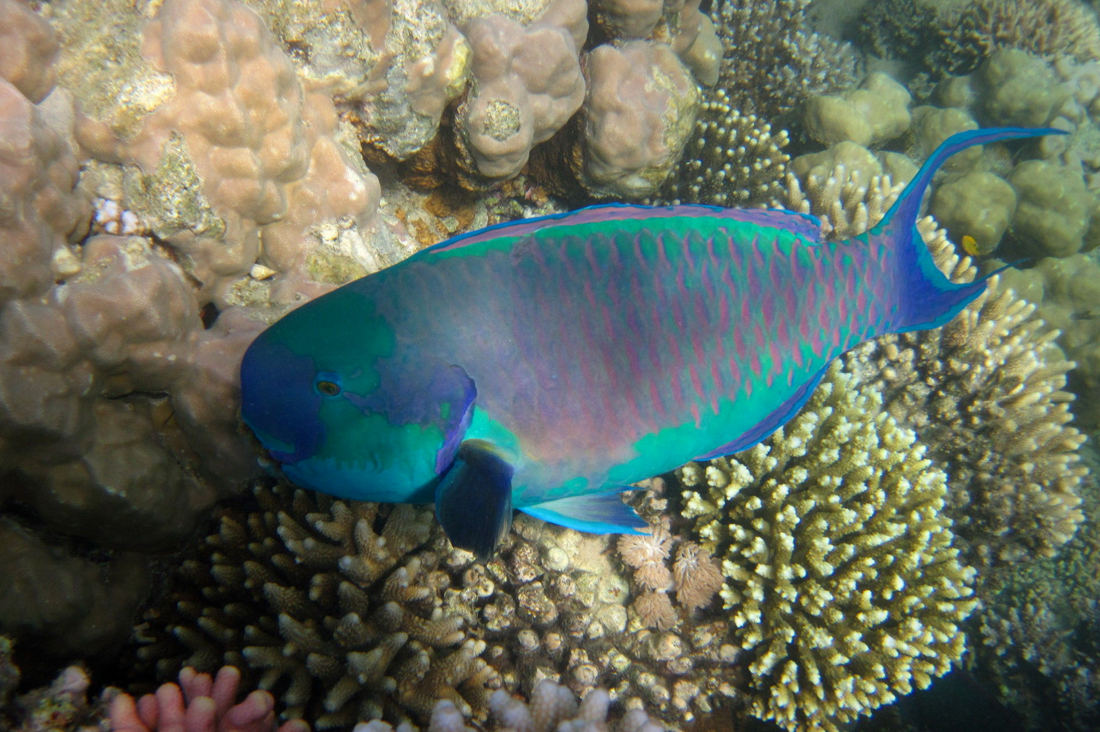- Classification
- ACTINOPTERYGII
- PERCIFORMES
- LABRIDAE
- Chlorurus
- strongylocephalus
Indian Ocean Steephead Parrotfish, Chlorurus strongylocephalus Bleeker 1854
Other Names: Heavybeak Parrotfish, Indian Ocean Steephead Parrotfish, Purple-headed Parrotfish, Steephead Parrots

A male Steephead Parrotfish, Chlorurus strongylocephalus - Egypt, Red Sea. Source: Mattia Menchetti / iNaturalist. License: CC by Attribution-NonCommercial
Summary:
A large parrotfish with a steep head profile giving the head a rounded shape, and a lunate tail with long caudal-fin lobes. Males are greenish to bluish-green with a pinkish-lilac streak on each body scale, and a large yellow patch on the cheek. Females are yellowish-green to greyish above, and brown to pinkish below, with dark green around the mouth and dark bluish-green margins on the tail.
Cite this page as:
Bray, D.J. 2020, Chlorurus strongylocephalus in Fishes of Australia, accessed 01 Jul 2025, https://fishesofaustralia.net.au/home/species/4936
Indian Ocean Steephead Parrotfish, Chlorurus strongylocephalus Bleeker 1854
More Info
|
Distribution |
Recorded in the Australian EEZ from Christmas Island and the Cocos (Keeling) Islands in the eastern Indian Ocean. Elsewhere the species is widespread with a patchy distribution in the Indian Ocean, from East Africa to Indonesia. Inhabits outer reef flats and reef fronts in coastal lagoons and outer reefs. |
|
Fisheries |
Taken as bycatch in parts of its range. |
|
Etymology |
The specific name strongylocephalus is from the Greek strongylos, (= round) and cephalus (= head) presumably in reference to the rounded head profile of this species. |
|
Species Citation |
Scarus strongylocephalus Bleeker, 1854, Natuurkundig Tijdschrift voor Nederlandsch Indië 7: 439. Type locality: Jakarta (as Batavia), Indonesia. |
|
Author |
Bray, D.J. 2020 |
|
Resources |
Indian Ocean Steephead Parrotfish, Chlorurus strongylocephalus Bleeker 1854
References
Allen, G.R. & Erdmann, M.V. 2012. Reef fishes of the East Indies. Perth : Tropical Reef Research 3 vols, 1260 pp.
Allen, G.R. & Smith-Vaniz, W.F. 1994. Fishes of Cocos (Keeling) Islands. Atoll Research Bulletin 412: 1-21.
Bellwood, D.R. 1994. A phylogenetic study of the parrotfishes family Scaridae (Pisces: Labroidei), with a revision of genera. Records of the Australian Museum, Supplement 20: 1-86.
Bellwood, D.R. 2001. Scaridae. pp. 3468-3492 in Carpenter, K.E. & Niem, T.H. (eds). The Living Marine Resources of the Western Central Pacific. FAO Species Identification Guide for Fisheries Purposes. Rome : FAO Vol. 6 pp. 3381-4218.
Bleeker, P. 1854. Specierum piscium javanensium novarum vel minus cognitarum diagnoses adumbratae. Natuurwetenschappelijk Tijdschrift voor Nederlandsch Indië 7: 415-448.
Choat, J.H. & Randall, J.E. 1986. A review of the parrotfishes (Family Scaridae) of the Great Barrier Reef of Australia with description of a new species. Records of the Australian Museum 38: 175-228.
Westneat, M.W. & Alfaro, M.E. 2005. Phylogenetic relationships and evolutionary history of the reef fish family Labridae. Molecular Phylogenetics and Evolution 36: 370-390.




